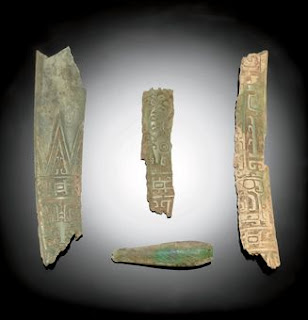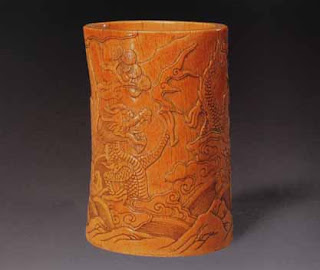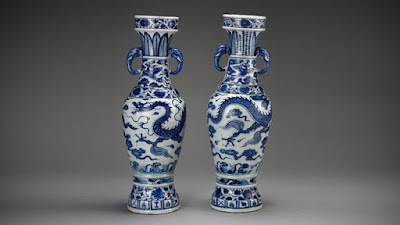Chinese Ivory Carvings a Brief History Over 2000 Years.
 |
| Rare 18th C. Qianlong Imperial Court Fan |
Chinese Ivory Carvings a Brief History Over 2000 Years.
By the end of the end of the 18th C. westerners had been exposed to the amazing skills with which the Chinese had been able to carve Elephant Ivory's through the items brought back during the China Trade Era.
The skill with which they were executed was unsurpassed any where in the world including Japan, long known for fine Ivory carvings. These stunningly fine works were the result of 2,000 years of evolution, through trial and error, thousands of different types of tools have been developed just for this craft. Eventually these objects were fashioned into finely worked Imperial fans adorned with exotic elements such as carved Horn bill with Enamel handles.
The Shang Dynasty (16th C. to 11 C B.C.)
The history of carving Ivory in China is a long an interesting one. The tradition of carving Ivories not surprisingly had its start in the Shang Dynasty with the carving of animal bones. The material used most commonly came from pigs, dogs, ox and deer including the antlers.
 |
| Shang Dynasty Bone Cup with Turquoise Inlay |
The rarest of the Shang bone carvings are usually in the form of cups with turquoise inlay. Often taking the form similar to bronzes of the era.
from beads, pendants, garment hooks, hairpins, arrowheads and so forth. The decorations were usually simple ones with incised designs, simple painting of pieces and inlaying them with various forms of turquoise, shells and small stones. Numerous hairpins have been found and over the years comprising over 8 types based on shape, size and carving, many having animal heads, birds etc. Interestingly archelogists found these rather odd looking Spatula shaped carvings in both Royal tombs and those of civilians. What they were used for remained a mystery for a long time until it was realized they weren't for serving food, but were in fact early Shuttles used in weaving. Similar in use to the shuttle cock used elsewhere around the world.
 |
| Zhou Dynasty Bone Carvings |
The carving skills mastered during the Shang Dynasty transitioned as many artistic endeavors do in China into it's successor the Zhou Dynasty. By then the workshops producing bone and ivory had become very sophisticated. New polishing techniques had been invented, with the advent of a primitive lathe smooth even circular objects were being made and carving techniques had evolved resulting in a very defined division of labor. The scale of production had become more of a commercial enterprise as demand for output grew almost endlessly. Much of the production resembled contemporary items produced in bronze and other materials. Hairpins, arrowheads, and Spatulas continued to dominate much of the output as well as elaborate combs with straight sides as well as lunar or crescent shaped examples as China entered the Warring States Period. (475-221 B.C.)
During the Warring States Period carving evolved very little with the exception scabbards and common jade forms being introduced, which since 1900 have since been found in numerous tombs. The other carvings include small pendants and disks known as Bi found buried in Houma and Shanxi.
The Han Dynasty (206 B.C.- 220 A.D.)
 |
| Ming Dynasty Low Relief Carved Ivory Box |
The carving industry continued to produce similar forms in jade, ivory and bone. The styles were often remarkably similar if not identical, the only difference being the material utilized. During this period it's been found that Ivory was by then being brought from new sources, not just India and Vietnam, excavations reveled a source for African ivory had been established as well when five full tusks were dug up at the tomb of the second king of the state of Nanyue in Guangzhou. Fascinatingly within this same tomb were found carved ivory Pyramids which clearly demonstrating just how well developed maritime trade between China, India Africa and Arab lands was. By this time items in Royal tombs also included Goblets inlaid with gold and precious stones.
Though painting pottery was very popular during the Han period, very few examples of painted ivory or bone have been as yet found.
 |
| Ming Dynasty Carved Ivory Brush Rest With Dragons |
The Jin to Tang Dynasties (265-907 A.D.)
Oddly during this period, almost 700 years, very little has been found of items carved from bone and ivory. A few tombs have yielded some combs, hair pins and some un-carved raw bones and ivory sections but little else. The biggest grouping were found buried in an ash pit located in Yangzhou.
Song Dynasty to Yuan Dynasty (907-1368 A.D.)
This was an interesting period for one significant reason, during the Song and Yuan Dynasties numerous written records exist about the importation Ivory and the establishment and maintaining of carving workshops. How Ivory was used has also been written about extensively during this time, yet no one single example has been found in either the Northern or Southern Song sites. None! While some wooden and bamboo carvings have been found, the dearth of Ivory examples is astounding.
 |
| Qing Era, Kangxi Period Carved Ivory Paste Box |
In Liao and Jin (10th-11th C.) tombs a few more were found, but mostly simple utilitarian items, combs, beads, small plaques.
During the Yuan period, their was also no increase in production despite the Mongol affinity for the color white with only a few ivory examples being excavated since the 1963. One was found in a tomb in Liaoning along with some Longquan Celadons , small glazed Jun ware bowls and brown slip glazed jars. Another example was excavated form the tomb of the parents of the well known Yuan rebel leader Zhang Shicheng (1321-1367). Who died just a couple years before the start officially of the Ming Dynasty.
Ming Dynasty (1368-1644) Qing Dynasty (1644-1911)
With the collapse of the Yuan Period China went back under the control of the Han Chinese. During this period, China went into its greatest period of economic expansion with the rapid growth of domestic and foreign trade, orderly Government in it's history. Chinese ships were produced in massive sizes, some over 550 feet long, often referred to as the Tribute Fleet.
As the Ming Dynasty got underway, under the new Imperial rulers and with their full financial support for education, housing, crop production and many other things needed to run an orderly Government. Along with this seed change, Imperial support for the arts flourished. vast sums of money flowed into the artistic community encouraging a return to classical forms as well as tasteful new innovations.
Ming Ivories were for the most part tended to be small examples, delicately carved statues, seals, brush rests, trays, boxes, hair pins, pendants and of course brush pots. Many were executed to serve on the scholar's table. The quality of the work was subtle, simple and devoid for the most part of ostentation and leaning more towards subtle elegance.
By the end of the Qianlong period Ivory carving had become perhaps the most finely worked of any carving ever known. The work included the making of baskets, all carved by hand with such fineness they resembled the screen you would have on a window. These were not woven, but were actually carved. Buyer's in the west marveled at the quality of these works and bought them en-masse. From sewing sets, to card holders, buttons, chess sets, elaborately inlaid boxes and furniture, calling card cases, fans, puzzle balls, doll heads, as well as using the superb surface ivory provided for painting miniatures, which were most often small portraits and Hong Scenes.During the Qing Dynasty Ivory Carving became much more technically developed reaching new heights during the reign of the Qianlong Emperor (1735-1796). By then China was a booming world power in trade. On a weekly basis ships from Europe were moving in and out of Chinese ports trading gold for silks, tea spices, porcelain, cotton and almost anything else they could buy to satisfy the home markets. These traders built upon the enterprises of previous traders building a trade route and business network like nothing ever before seen in human history. The result? an even more massive demand for Asian goods by the west. By the second half of the 18th C. the American colonies were among the buyers as well, with Salem, Massachusetts being among the most important by 1800. At one point Salem has so many ships going to China, the Chinese thought that Salem was a country.
With the collapse of the Yuan Period China went back under the control of the Han Chinese. During this period, China went into its greatest period of economic expansion with the rapid growth of domestic and foreign trade, orderly Government in it's history. Chinese ships were produced in massive sizes, some over 550 feet long, often referred to as the Tribute Fleet.
 |
| Ming Period Ivory Brush Pot |
As the Ming Dynasty got underway, under the new Imperial rulers and with their full financial support for education, housing, crop production and many other things needed to run an orderly Government. Along with this seed change, Imperial support for the arts flourished. vast sums of money flowed into the artistic community encouraging a return to classical forms as well as tasteful new innovations.
Ming Ivories were for the most part tended to be small examples, delicately carved statues, seals, brush rests, trays, boxes, hair pins, pendants and of course brush pots. Many were executed to serve on the scholar's table. The quality of the work was subtle, simple and devoid for the most part of ostentation and leaning more towards subtle elegance.
 |
| Fine 19th C. Carved Ivory Puzzle Ball for the China Trade Market |
 |
| Fine Rare Late 19th C. Carved Chinese Ivory Vase in the Qianlong Style |
By the second half of the 19th C. Ivory carvers were still busily at work producing larger and more unusual forms including large Luohan figure sets, a vast array of more calling card boxes, table boxes based on European styles, statues reminiscent of Ming examples as well as elaborately carved vases based on Imperial Kangxi and Qianlong period examples as well a doing other vases in the form of Ancient bronzes.
Despite the world wide ban on harvesting elephant trunks in Africa, thousands of tons of fresh Ivory reaches China today for carving.
To see more about the history of Dynastic China Visit the University of Southern California's Chinese History Pages, its quite excellent!
Feel free to email or call with any questions about your own Chinese porcelains or their values.
Thank you for visiting ~ Peter Combs
Gloucester, MA 978-283-3524




Mr. Peter Combs
ReplyDeleteG'day to you.
May I have your email address; I have with me a very rare ivory sculpture with micro chinese calligraphy carvings done by a famous micro carving artist from the 1950s. His works are kept mainly by the National Palace Museum in Taiwan
My email address is raresculpture2@gmail.com
Many thanks & my best regards
Mr. Peter Combs
ReplyDeleteG'day to you.
May I have your email address; I have with me a very rare ivory sculpture with micro chinese calligraphy carvings done by a famous micro carving artist from the 1950s. His works are kept mainly by the National Palace Museum in Taiwan
My email address is raresculpture2@gmail.com
Many thanks & my best regards
Chinese Ivory Carvings A Brief History Over 2000 Years. >>>>> Download Now
ReplyDelete>>>>> Download Full
Chinese Ivory Carvings A Brief History Over 2000 Years. >>>>> Download LINK
>>>>> Download Now
Chinese Ivory Carvings A Brief History Over 2000 Years. >>>>> Download Full
>>>>> Download LINK UH